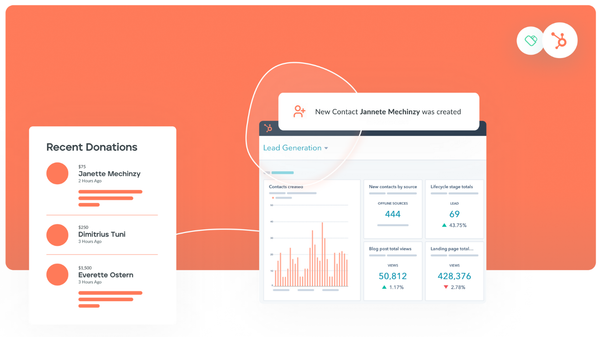What Nonprofits Should Know About Form 8283
Noncash charitable contributions, ranging from artwork to vehicles, offer substantial benefits to nonprofits but require careful handling. This blog provides essential guidance for nonprofits to assist donors in navigating these requirements, ensuring compliance and maximizing benefits.

Noncash charitable contributions play a critical role in many nonprofits’ fundraising efforts. From vehicles to artwork, they can be major donations – but they can also cause headaches for donors. To deduct these donations, donors must fill out Form 8283, and the Internal Revenue Service (IRS) may scrutinize these donations closely, especially if they’re over $5,000. Here’s what nonprofits need to know to help large donors complete Form 8283 for noncash charitable donations.
What Is Form 8283?
IRS Form 8283, Noncash Charitable Contributions, is a document that taxpayers must complete to report noncash donations valued over $500 made within a tax year. It provides details about the donated property, the nonprofit organization it was donated to, and the value of the contribution. Donors need to accurately complete Form 8283 to deduct these donations on their federal tax returns. Nonprofits can help by providing them with the information they need.
Do Individuals Need to File Form 8283?
Yes, individuals who donate noncash items worth more than $500 in a single year to a nonprofit organization are required to file Form 8283. They will typically file it with their income tax returns and claim a deduction for these contributions.
Do Corporations Need to File Form 8283?
Yes, similarly to individuals, corporations making noncash charitable contributions exceeding $500 must also file Form 8283. This ensures that businesses accurately report and substantiate their charitable donations, and allows them to take advantage of associated tax deductions.
When Does Form 8283 Usually Become Available?
The IRS updates and releases Form 8283 annually. It typically becomes available by the end of the year or in early January, in time for tax preparation season – and for year-end giving campaigns. Donors should check the IRS website for the most current version before completing and filing their taxes.
Examples of Noncash Charitable Contributions
There’s another important definition to know when answering the question, “What is Form 8283?” Now you know it’s for noncash charitable contributions – but what is that, exactly? It can be anything that isn’t money: clothes, household goods, and more. (Unlike in-kind donations, which are services the organization uses directly, noncash donations are usually converted into money.) But Form 8283 applies to larger donations, like these examples.
Donations of Stock
Donating stock to a nonprofit is financially savvy for both the donor and the charity. If the stock has appreciated in value since its purchase, the donor can avoid paying capital gains tax by donating the stock directly to the charity. The nonprofit can then sell the stock without incurring capital gains taxes. Donors need to transfer the stock directly to the charity and should obtain a receipt that includes the name of the stock, the number of shares donated, and the date of the transfer. Then they’ll need to fill out Form 8283 for stock donations worth over $500.
Donations of Cryptocurrency
Similar to stocks, donating cryptocurrency can offer tax advantages: Donors can potentially avoid paying capital gains tax on appreciated cryptocurrency by donating it directly to a nonprofit. Many nonprofits aren’t able to accept direct cryptocurrency donations, but can do so through donor-advised funds. They should be prepared to provide the donor with a receipt that includes the type of cryptocurrency, the amount donated in units, and the date of donation. Valuation is based on the market price of the cryptocurrency at the time of donation.
Furniture Donations
Furniture donations can make a significant difference to many nonprofits, especially those that provide housing or office space. The value of the furniture for Form 8283 purposes typically depends on its condition and market value. Donors should document the condition of the furniture at the time of donation and, if possible, provide a valuation guide or a professional appraisal for higher-value items. A receipt from the nonprofit should describe the item but not assign a value.
Donations of Cars
Many nonprofits accept car donations, which can be a significant source of funds whether the vehicle is used for the charity’s operations or sold to fund programs. The deduction amount on Form 8283 for a car donation depends on how the nonprofit uses the car and its fair market value. If the charity sells the car, the donor’s deduction is limited to the gross proceeds from the sale. Nonprofits should provide a receipt that includes a description of the car and, if sold, how much it sold for.
Artwork Donations
Many wealthy donors enjoy donating art to a cause, especially for charity fundraisers.
But for the purposes of Form 8283, there are certain rules donors must follow: To deduct the fair market value, they must be a collector (not an artist or art dealer) and they must own the art for more than a year before donating it, among other requirements. All noncash charitable contributions worth more than $5,000 also require a qualified appraisal. The nonprofit should acknowledge receipt of the artwork without valuing it, and indicate that the artwork will be used in a way that's related to its mission.
What Are the Form 8283 Requirements for Nonprofits?
Nonprofits must provide donors with a written acknowledgment for their donation, detailing the name of the organization, a description of the donated property (not the value), and a statement of whether any goods or services were provided in exchange for the donation. For donations that require an appraisal, the organization must also complete Section B, Part IV of Form 8283, which we’ll go over below.
How Do Donors Fill Out IRS Form 8283?
As a nonprofit, you’re only required to provide a receipt for donations over $500. (This is also what your donors will need in order to file Form 8283.) If you’ve done that, you’ve fulfilled your obligations. However, if your donors need more information on how to fill out Form 8283, send them this quick checklist:
- Add up your donations: Begin by assessing whether the total value of your noncash contributions over the course of the tax year exceeds $500. If so, Form 8283 is required to claim your deduction.
- Identify the right section: Form 8283 Section A is for items with a claimed deduction of less than $5,000 each and for publicly traded securities, regardless of value. Form 8283 Section B is for items with a claimed deduction of $5,000 or more, and certain specific donations like conservation easements, regardless of the claimed deduction amount.
- Describe the donation: For Section A, provide a general description of the donated item(s), including the physical condition. For Section B, in addition to a detailed description, you must include how you obtained the property (purchase, gift, inheritance, etc.), the date you obtained the property, and the cost.
- Provide the value: Determine the fair market of the donated property. This is the price at which the property would change hands between a willing buyer and a willing seller with reasonable knowledge of relevant facts.
- Get an appraisal: For items in Section B, a qualified appraisal is required for the donated property if its value exceeds $5,000. The appraisal must be conducted by a qualified appraiser no earlier than 60 days before the donation. Attach the appraisal summary to Form 8283 if required.
- Add the nonprofit’s details: Provide the name and address of the nonprofit organization that received the donation. You will also need to specify if the organization is a 501(c)(3) and if it provided any goods or services in exchange for the donation.
- Sign and attach Form 8283: For Section A, your signature is not required on the form. For Section B, both you and an authorized official of the receiving organization must sign the form. Attach it to your federal income tax return and keep a copy for your records.
Give Your Donors an Advantage with Donately
When it comes to Form 8283, the most important thing nonprofits can do is keep accurate records, provide detailed receipts, and communicate openly with donors. By understanding how to properly fill out the form, when appraisals are needed, and the importance of accurate valuation, nonprofits can help donors comply with IRS rules. And that can strengthen trust and encourage future contributions.
The Donately platform helps you automatically thank donors, send donation receipts, and keep track of donor data for donations large and small. We work with thousands of nonprofits to maximize their donations and build relationships with donors, and we can help you, too. Sign up for a free account to get started with our useful tools.





